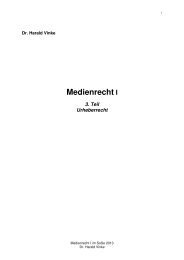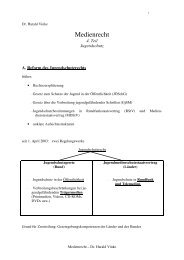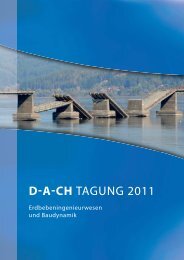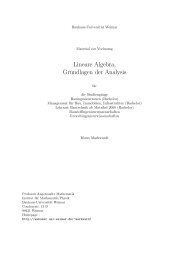Katalog - Home - Bauhaus-Universität Weimar
Katalog - Home - Bauhaus-Universität Weimar
Katalog - Home - Bauhaus-Universität Weimar
Erfolgreiche ePaper selbst erstellen
Machen Sie aus Ihren PDF Publikationen ein blätterbares Flipbook mit unserer einzigartigen Google optimierten e-Paper Software.
The students used narrative photography,<br />
photo journalism, documentation photography,<br />
objective photography – just to<br />
mention a few media-specific areas of<br />
photography – for their treatment of the<br />
topic. The work was shown in<br />
self-selected presentation forms.<br />
The Congress<br />
It was self-evident to present a represen-<br />
tative selection of the photography work<br />
at the international congress “Orbit 2006”<br />
in <strong>Weimar</strong>, in order to offer the visiting<br />
scientists, aside from their everyday<br />
acquired knowledge, a glimpse into the<br />
project work of young students of the<br />
design faculty, who have obviously dealt<br />
with the discovery of the worthless and<br />
have recognised the importance of the<br />
problem. At this point I would like to es-<br />
pecially thank Werner Bidlingmaier for<br />
his dedication, without which the realisation<br />
of this exhibition and catalogue<br />
would not have been possible.<br />
Prof. Dr. Karl Schawelka<br />
The Transformation<br />
of Rubbish<br />
The human corpse might be the prototype<br />
for how we deal with waste with its connotations<br />
to the things to be displaced,<br />
refused, the disgusting, shapeless, the de-<br />
composing, the weird and the infectious.<br />
Not only do we know as humans, most<br />
likely as the only living beings, that we are<br />
destined to die, but anthropologists even<br />
let the actual history of homo sapiens begin<br />
with the emergence of burials.<br />
Indeed: As there was quite recently an individual<br />
human being, having consciousness,<br />
who talked, acted and to whom affective<br />
and emotional ties existed – the corpse<br />
is only a bare, dead image of the former<br />
person, however, being similar to him, but<br />
without essential features. Furthermore:<br />
One has to dispose of the corpse in some<br />
way, despite reverent memories clinging to<br />
him, in order to not endanger the living.<br />
This is not the right place to discuss the different<br />
forms of the death cult, although the<br />
most widespread forms like burying and<br />
burning are characteristic for our practices<br />
with rubbish. However, it should be noted<br />
that, in any case, an individual, separated<br />
area for the dead was created outside the<br />
realm of the living, which is associated with<br />
a taboo, forbidden contact. Now, the term<br />
of “taboo” is ambivalent. Not only the<br />
impure, but also the sacred is taboo, and<br />
without the ancestor cult, without tradition,<br />
without the corresponding relics, without<br />
its great deaths, no society can survive.<br />
Even we modern, enlightened contemporar-<br />
ies go on a pilgrimage to the tombs of<br />
Goethe and Schiller or to Buchenwald and<br />
explain to ourselves and the world, what<br />
it means to be a German.<br />
As on one hand, our everyday world is char-<br />
acterised by things, that have been made<br />
and pass away, that are functional and then<br />
lose their function over the course of time,<br />
that have their time, then gradually lose<br />
their value – just think of cars, houses,<br />
computer programmes and TV series – and<br />
become rubbish when useless, which is<br />
disposed of in special areas; on the other<br />
hand, everything that retains its value, that<br />
finds its place beyond the logic of gradual<br />
attrition, paradoxically, descends from the<br />
area of tabooed rubbish.<br />
In the end, every old-timer or historical<br />
monument, even the flat-iron in the museum<br />
must have once been ruinous and<br />
useless or obsolete, before they were<br />
taken out of the area of the normal objects<br />
of daily use and classified into its<br />
own economical logic as virtually priceless.<br />
We maintain special places, where the en-<br />
during is located, such as museums and<br />
collections. Everything, which is considered<br />
as being museal, is removed from the cycle<br />
of functional things. A radio in a museum<br />
is no longer an object of daily use, it represents<br />
an era from the past, the spirit of its<br />
time, the culture, which produced such a<br />
design etc. and conjures up the memory<br />
of a far away and irretrievable past.<br />
Artists, as specialists for the reevaluation<br />
of values, have been bestowed by society<br />
with the power to produce permanent,<br />
sacred, irretrievable and priceless things,<br />
in other words: things that are excerpted<br />
from the sphere of consumption, even if<br />
they by no means always succeed. Just as<br />
alchemists, they should create value from<br />
the valueless. However, their objects are<br />
principally not subject to the conventional<br />
course of life of functional products,<br />
devaluating their value mercilessly until<br />
they became rubbish at the end, but<br />
instead serve the purpose of triggering<br />
thoughts and memories.<br />
Artists, especially contemporary ones,gladly<br />
turn to the aesthetic of rubbish. They are<br />
irresistibly attracted to that which possesses<br />
characteristics of the ruinous, shapeless or<br />
abjected, without a special useful purpose<br />
and, therewith, declared to be worthless.<br />
They transfer that, which has been eliminated<br />
by modern society, i.e. the banal,<br />
devaluated and worthless, to such cultivated<br />
places as museums, galleries and exhibitions.<br />
They are not interested in the affront<br />
of the aesthetic hierarchy. From their<br />
shaman-like descent into a fragmentary<br />
underworld without sense, in the non-places<br />
of the eliminated and secluded, they return<br />
with the discovery of bewitching new forms.<br />
That, which was otherwise ignored, is reanimated<br />
by them. They succeed in a metaphoric<br />
raising of dead matter to a new life.<br />
Their means are refinement, isolation and<br />
framing, arranging and also the shifting<br />
of context. The refinement undertaken on<br />
the phenomenal given matter separates<br />
and distils. With their characteristic preci-<br />
sion, artists apply their subtle judgement<br />
and differentiation on apparently raw<br />
meaningless and useless entities, thereby<br />
taking advantage of their memento character.<br />
It is precisely because of the visible<br />
decomposition that the remains singled out<br />
by the artists serve as signs for the invisible,<br />
the absent, the beyond or the elapsed.<br />
Prof. Hermann Stamm<br />
Die Entdeckung<br />
des Wertlosen<br />
Vor vier Jahren kam es zu einer Begegnung<br />
mit Werner Bidlingmaier. Aus einem<br />
Gespräch entwickelte sich die Idee, gemeinsame<br />
Projekte zu realisieren. Wie sollte<br />
das denn gehen zwischen einem Künstler<br />
und einem Ingenieur, Prof. Dr.-Ing. habil.,<br />
noch dazu dieser sich Ruhm und Ehre in<br />
der Abfallwirtschaft verdient hatte, währenddessen<br />
der andere nach den Inhalten<br />
und Konzepten gestalterischer und künstlerischer<br />
Bildstrategien suchte?<br />
Aus dieser Begegnung entstand nicht nur<br />
eine besondere Freundschaft, sondern auch<br />
ein gegenseitiges Austauschen von Themen<br />
die trotz unterschiedlichster Natur zu<br />
gemeinschaftlichen Projekten wuchsen.<br />
Nicht nur die Ausstellungsvorhaben der<br />
scheinbar unterschiedlichen Disziplinen verschiedener<br />
Berufsfelder, sondern vor allem<br />
das gegenseitige Verständnis und der Respekt<br />
in der Diskussion, die in unterschiedlichen<br />
Präsentationen sich verdeutlichten<br />
ernteten neben dem Erstaunen der Besucher<br />
auch deren besondere Anerkennung.<br />
Was war geschehen?<br />
Zwei Wissenschaften im klassischen Sinne<br />
übten interdisziplinär einen Austausch.<br />
Ziel war, gemeinsam erarbeitete Gedanken<br />
und Erfahrungen in einer übergeordneten<br />
kommunikativen Plattform darzustellen und<br />
demRezipienten vor Ort neue gedankliche<br />
Ebenen zu eröffnen. Zudem wurden tempo-<br />
rär auch Ausstellungsorte gewählt, an denen<br />
man die Abfallwirtschaft oder die Kunst<br />
nicht gerade vermutet.<br />
Was bewegt einen, sich dieser<br />
gemeinsamen Aufgabe zu stellen?<br />
Neben den Eindrücken der Reisen, die mich<br />
vor allem nach Asien und Australien führten,<br />
schaute ich weit über den Tellerrand der<br />
mathematischen und praktischen Arbeit<br />
eines Bauingenieurs hinaus. Diese mir frem-<br />
de Welt mit exotischen Eindrücken von<br />
Müllkippen und den darauf lebenden Men-<br />
schen bis hin zu den Projekten der dringend<br />
geforderten Verwertung von Abfall<br />
und der Erhaltung und Gewinnung von<br />
Trinkwasser, deren es noch weltweit größter<br />
Anstrengungen bedarf, erschütterten meine<br />
Vorstellungen von menschlichem Dasein,<br />
Wissen und vor allem dem Leben in frem-<br />
den Kulturen. Gleichzeitig ergaben sich für<br />
mich völlig neue Impulse,<br />
diese Eindrücke in meine künstlerischen<br />
Konzepte einfließen zu lassen.<br />
Die Lehre als Becken vieler Einflüsse<br />
Als Lehrender einer Hochschule fließen nat-<br />
ürlich die in der Praxis erarbeiteten Werte<br />
in die Arbeit mit den Studenten ein. So liegt<br />
es nahe – in einem Projektstudium, wie es<br />
an der Fakultät Gestaltung der <strong>Bauhaus</strong>-<br />
<strong>Universität</strong> seit 13 Jahren erfolgreich durch-<br />
geführt wird – die Fragestellungen, die<br />
Lehrende sich bewusst machen, auch in<br />
Forschung und Lehre einfließen zu lassen.<br />
In unserem Falle der künstlerisch-gestalterischen<br />
Erarbeitung von Problemstellungen.<br />
Im Sommersemester 2006 wurde<br />
von Dipl.-Des. Götz Greiner und mir das<br />
Projekt „Die Entdeckung des Wertlosen“<br />
im Studiengang Visuelle Kommunikation<br />
angeboten. Gerade in diesem Projekt war<br />
gefordert, sich mit den unterschiedlichen<br />
Begrifflichkeiten von Werten auseinander<br />
zu setzen. Werte an sich, Werte eines<br />
Themas, Werte unterschiedlicher Medien-<br />
strukturen bis hin zur Erarbeitung der Foto-<br />
grafie in analogen und digitalen Werten,<br />
um nur einige anzusprechen. Diese positiv<br />
besetzten Werte sollten nun scheinbar<br />
Wertloses aus dem Schattendasein herausführen.<br />
Mikro- und Makrowelten entstan-










